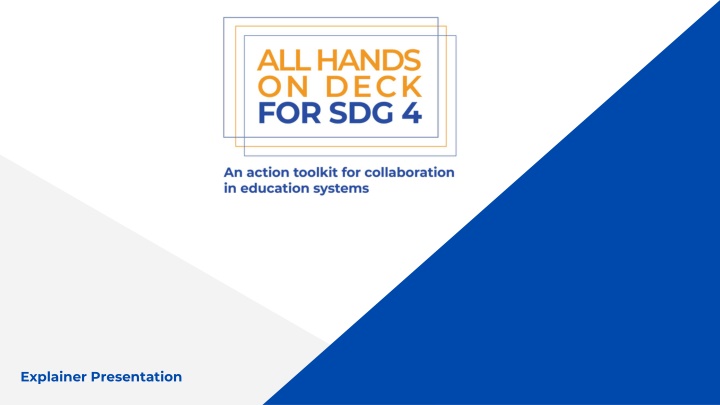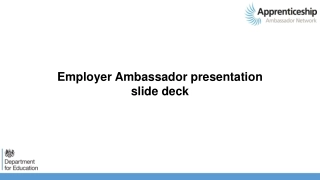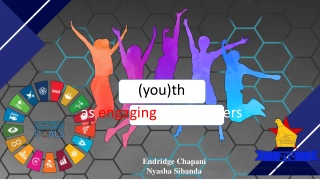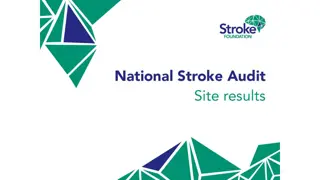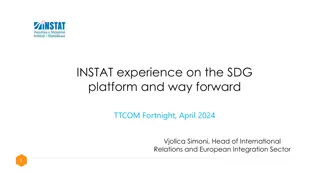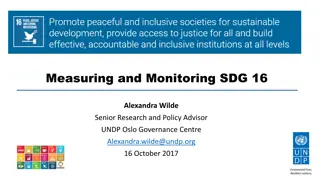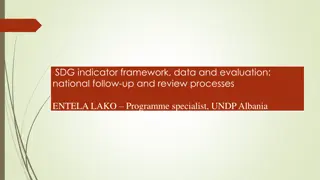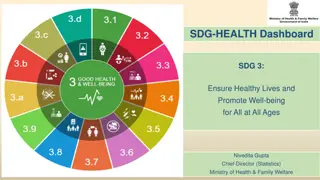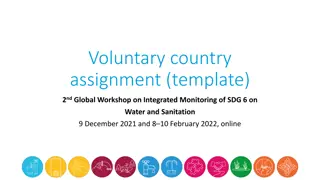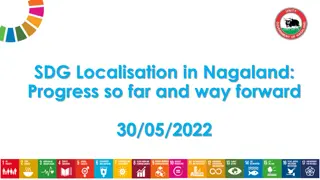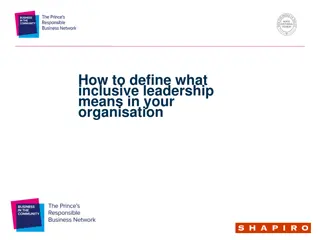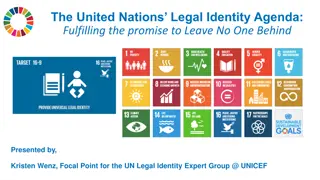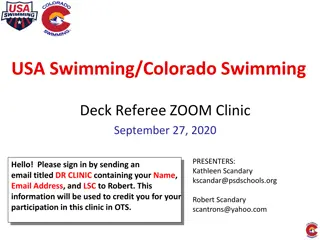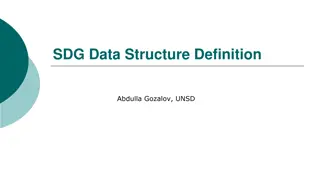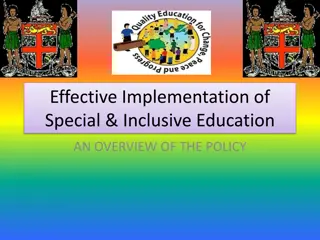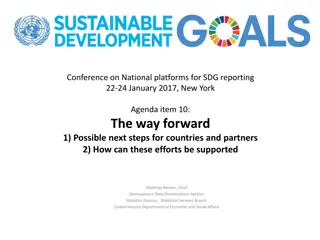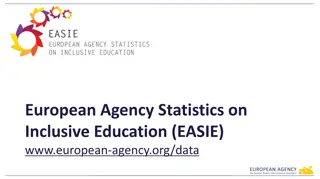All Hands On Deck For SDG 4: A Strategy for Inclusive Education Planning
The All Hands On Deck For SDG 4 Initiative aims to bridge the gap between state and non-state education providers to enhance planning, dialogue, and implementation in underserved communities. Through case studies and a strategic guide, the initiative seeks to create a future where governments leverage expertise from all actors in the education sector for equitable access to quality education.
Download Presentation

Please find below an Image/Link to download the presentation.
The content on the website is provided AS IS for your information and personal use only. It may not be sold, licensed, or shared on other websites without obtaining consent from the author.If you encounter any issues during the download, it is possible that the publisher has removed the file from their server.
You are allowed to download the files provided on this website for personal or commercial use, subject to the condition that they are used lawfully. All files are the property of their respective owners.
The content on the website is provided AS IS for your information and personal use only. It may not be sold, licensed, or shared on other websites without obtaining consent from the author.
E N D
Presentation Transcript
What is All Hands On Deck For SDG 4? The All Hands On Deck For SDG 4 Initiative comprises: The Goal The inclusion of all non-state education providers and actors working in underserved communities in government policy planning, dialogue, implementation, and monitoring. a) Four case studies of initiatives that have successfully fostered engagement between state and non-state actors, b) A practical, evidence-based tool to support organisations in planning their engagement strategies. The Problem The affordable non-state sector, including low-fee or no-fee private schools, religious schools, and the ancillary services which support them, are often excluded from government policy planning, dialogue, implementation, and monitoring. This limits the diversity of experiences involved in formulating and implementing policies to expand inclusion to education, and ignores a significant proportion of the school-going population. To frame the purpose for All Hands On Deck For SDG 4, we have defined a goal, a challenge, an imaginable future, and a pathway to reach that future.
Where are we going? Imagining the future In an ideal future, governments, as duty bearers for education, will be able to rely on expertise from all non-state actors involved in education. This would allow them to leverage the different experiences and expertise that exist within the affordable non-state sector, helping to contribute to policy dialogue and delivery, to expand equitable access to quality education. How we are helping to get there The All Hands on Deck strategy guide aims to support greater engagement between non-state actors and governments by: a) Using the literature on systems change to develop our understanding of how initiatives can lead to systemic change, through better engagement between state and non-state actors. Using that understanding to develop case studies of successful initiatives which have shifted narratives to more productive engagement between state and non-state sectors. Create a publicly available toolkit based on the case studies, to guide non-state actors through their planning for increasing productive engagements with governments. b) c)
Who is our audience? (2) Stateandnon-stateactorscollaborativelysupporting Governments sit at the heart of education systems, as the duty bearers for education planning. governmentwith deliveringeducation State Actors Around governments sit a wide constellation of state and non-state actors, who collaborate to support the delivery of education for all. These national actors include state and non-state schools, as well as state schools managed by non-state actors, non-formal education providers, tertiary institutions, teacher training colleges, providers of curricular materials and other ancillary services. (1) Government Duty bearer for education planning Non-State Actors Surrounding these national eco-systems are an array of international actors who support both governments and those involved in service delivery. (3) International Organisations providingfinancing and technical assistance to governments and non-state organisations
The Case Study Process Exclusion and Selection criteria applied to select 5 Initiatives 1a Consultations with Members and Funders 2 3 4 Outputs: 5 internal case study briefs to support toolkit development 5 Deep Dive Case Studies Landscape Mapping Research Design 1b Review existing frameworks on change making Summary information gathered against mapping framework for 15- 20 initiatives Qualitative data from documents and KIIs used to document initiatives
Four Case Studies The Regional Education Learning Initiative (RELI) Engagement between the Ministry of Education and private schools in Lagos State RELI is a coalition of more than 70 non-state and civil society organisations working in education in Kenya, Tanzania, and Uganda. Formed in 2017, RELI aims to generate evidence to support governments in improving education quality. Most learners in Lagos State are in low-fee private schools, but until 2008 the number of schools wasn t known. Beginning with a DfID funded school census, a constellation of organisations has been working to improve the quality of engagement between the MoE and private schools. Transforming Education in Cocoa Communities (TRECC) The private schools work of the Central Square Foundation (CSF) TRECC was a collaboration between the Jacobs Foundation, the government of C te d Ivoire and a network of cocoa-producers. The initiative aimed to reduce child labour in cocoa communities through joint funding and management of pilots to find innovations to improve education quality. These innovations could then be scaled up in the government system. CSF s work on private schools aims to improve the quality of education in the private sector by a) improving the quality of data on learning outcomes, thereby supporting informed parental choice, b) supporting improved regulation of private schools, and c) using evidence to build more productive narratives around private schooling.
Why these cases? We chose our case studies to learn more about how engagement is built through: a) Coalition building between non- state actors (RELI) b) Non-traditional partnerships of state and non-state actors (TRECC) c) Generating evidence to create and sustain new narratives around engagement (CSF) d) Eco-system collaboration over long periods of time (Lagos State) TRECC C te d Ivoire Central Square Foundation (various states in India) Lagos State Nigeria Regional Education Learning Initiative (RELI) Kenya, Tanzania & Uganda
Building on this knowledge Using what we have learned from our four case studies, we have built this toolkit to support you as a non-state organisation in formulating strategies for building constructive engagement. Enablers of change How does who you are, and where you work affect what you do? 1 At the heart of this toolkit is an action framework which maps the enablers, activities and outcomes for building engagement (shown on the next slide). Using this framework, the rest of this toolkit focuses on enablers of change, activities to build engagement, and alignment to outcomes. Activities to build engagement What can you do to foster better engagement and collaboration? 2 The information and activities in the rest of this session will help you build your strategy, based on these three pillars. Alignment to outcomes How to ensure whatyou re doing will take you where you want to go. 3
The Action Framework 2 Activities to build Engagement A shared understanding, trust and common goals Policy Windows Lack of data & evidence and shared understanding on non-state actors What can be done Timing Opportunities Data & Evidence Generation Trust Building A mindset that sees non-state education as outside public policy Political and Social Context Evidence & data to understand and act System Level Goal Public & private operate as one system, supported by government regulation & partnerships; and delivering goals of equity & learning Ecosystems Problem Statements Coalition Building Issue Framing Enablers of Change 1 Tested policy solutions Technical Capabilities Lack of policy & delivery solutions for public-private collaboration Alignment Modelling & Testing solutions Catalytic Funding Characteristics and Assets Funding, platforms & delivery partners to implement solutions Lack of catalytic funding & platforms to support public- private collaboration for what purpose Skilful Leadership Commitment Outcomes of Increased Engagement 3
Enablers of change 1 How does who you are, and where you work affect what you do?
Where are you starting from? Policy Windows Your starting point for work on building systems change through better engagement is defined by two things: Timing Opportunities The opportunities afforded to you by your context should lay the foundation for your work in systems change. These can either be in your favour meaning that you should take the opportunity to act or they may be against you, in which case you may want to adapt, or be patient and wait for opportunities. Political and Social Context Ecosystems Technical Capabilities Alignment Your characteristics and assets as an organisation define what kind of activities you are likely to be successful in delivering. They also help you reflect on what your strengths are, and which areas you can strengthen, either through organisational growth or through partnership. Characteristics and Assets Skilful Leadership Commitment
Enablers of change Characteristics and Assets Opportunities Commitment Timing Change is fostered by commitment. This can be achieved by local organisations with deep roots, or outside organisations willing to make long-term commitments. Change takes time, and enacting change relies on patience to wait for change, trust to persist with activities, and opportunism to act when opportunities arise. Alignment Policy Windows This means alignment within an organisation in terms of having a clearly defined, consistent message, as well as alignment with government priorities and policies. Opportunities for change can arise suddenly from changes in policy. Whether these arise from long advocacy processes, or shifts in political landscape, they create an opportunity for change. Technical Capability Political & Social Context Education is an important public issue. Understanding the public s view of the issue, and how this relates to the political position can build understanding of opportunities. As an organisation, having a specific and clearly defined technical niche is an asset for building collaboration and credibility. Skilful Leadership Ecosystems Change is often driven by skilful individual leadership within organisations, which can drive and shape agendas, and build relationships. Who else is working around you? The presence of other aligned actors with complimentary skills can create an opportunity for collaboration and change.
Case Study Spotlights For CSF, technical ability in synthesising data meaningfully, as well as credibility built through years of strong technical work, have been crucial assets. CSF built credibility for their work on private schools through a strong technical base in supporting foundation learning across the education sector. Building on technical capability The Lagos State case study looks as a 15-year period, over which there has been steady progress towards better engagement. The initial school census funded by DfID may not have seemed as influential at the time as it does from a 15-year perspective. The key impacts of that school census are still being built upon, and it has informed a new way of thinking about the non- state sector in the state. Timing and patience
Activities to build engagement 2 What can you do to foster better engagement and collaboration?
What should you do? What you do will be defined by the opportunities present in your context, as well as the characteristics and assets of your organisation. We found three groups of activities that were impactful: Data & Evidence Generation Data & evidence generation is important for shifting narratives, identifying issues and providing solutions. Coalition Building Coalition building, particularly of non-traditional groups, is a strong pathway to greater collaboration. Catalytic Funding For funders, providing catalytic funding to engagement is a crucial activity.
What works? Data & Evidence Generation Coalition Building Catalytic Funding Evidence can be used for mapping, exploring and testing solutions. We can divide coalitions into either formal or informal coalitions. Catalytic funding is funding which has a sustainable impact beyond the funding period. When generating evidence to build collaboration, focus on: Framing evidence within a clear narrative Aligning evidence to the questions being asked in the sector Involving a wide coalition in evidence generation When building coalitions, think about: Establishing alignment around a common goal Establishing trust and commitment Integrating diverse perspectives Building formal authority For funding to be catalytic, the funder should: Fund with trust and commitment Fund momentum don t use funding to generate momentum Take a backseat and let the initiative take centre stage
Case Study Spotlights The RELI network was built on trust, commitment and common goals. The common goal of improving learning is something that unifies the more than 70 organisations. Trust and commitment have been built through shared activities and successes, such as the Assessment of Lifeskills and Values in East Africa (ALiVE) initiative. This trust and commitment takes time to build, and was achieved through collaborative success. Building the RELI Coalition CSF s work on evidence generation The state of the sector report uses a wide evidence base to frame a new way of thinking about how government engages with private schools. This evidence-based narrative is emphasised throughout the report. Following up the report with media engagement reinforced the narrative and built momentum for the report. This focus on narrative-building ensured that the evidence started a broader conversation in the sector. The role of catalytic funding for TRECC The funding from the Jacobs Foundation was important in building trust in the TRECC model but was always contingent on co-financing from cocoa-producers to fund the exploratory pilots. For CLEF, the follow-on programme to TRECC, this co-financing has been expanded to include funding from the government of C te d Ivoire. Importantly, the funding built on a clear recognition of need, and patience to ensure trust and commitment from co-financers.
Alignment to outcomes 3 How to ensure what you re doing will take you where you want to go
Three Pathways to Link Problem to Solution Impact From our case studies, we have built a framework for action which captures the enablers of change, activities to support better engagement, and the outcomes that can lead to better engagement. Outcome Intention In the first two parts of this presentation, we explored the enablers and activities in the action framework. In this section, we zoom in on three pathways within the framework. We look at how different combinations of activities can be optimised to create theories of change, responding to specific problems which cause a lack of collaborative engagement between state and non-state actors. Activities Problem
Pathway 1 Issue Framing A lack of a common evidence base on the quality of outcomes in non-state education can lead to distrust, and reduce opportunities for productive collaboration. In our problem statements, we capture this as a lack of evidence and shared understanding on non-state actors, as well as a mindset that sees non-state education as outside public policy. From our case studies we see a clear pathway to link the generation of data and evidence, and the development of trust, shared understanding, and common goals between state and non-state actors. What we have learned: Activities Outcomes Impact Issue framing starts with a common goal shared by all (e.g. quality education for all) Evidence can build a logical link between the current and ideal state Understanding different positions on an issue is central to finding a common framing. Who you are defines to a certain extent how your message will be received. Problem Statements For what purpose What can be done Lack of data & evidence and shared understanding on non-state actors System Level Goal: public & private seen as one system supported by government oversight & partnerships; and delivering goals of equity & learning Evidence & data to understand and act Data & Evidence Generation Issue Framing A mindset that sees non-state education as outside public policy A shared understanding, trust and common goals
Pathway 2 Modelling and Testing Solutions From our problem statements, we have a lack of policy and delivery solutions for public-private collaboration. In terms of our system level impact, this problem again presents a clear barrier in developing a single system in which platforms exist for governments to collaborate with non-state actors in delivering goals of equity and learning. Our case studies show how a combination of strong evidence generation and catalytic funding can build potential policy solutions. What we have learned: Activities Outcomes Impact Problem Statements For solutions to be accepted, they need to be aligned to a clearly recognised need. Robust, credible evidence is central to demonstrating impact and scaling solutions. Scale in the education system can only be achieved in partnership with governments. System Level Goal: public & private seen as one system supported by government oversight & partnerships; and delivering goals of equity & learning Data & Evidence Generation Lack of policy & delivery solutions for public-private collaboration Modelling & Testing solutions Tested policy solutions Catalytic Funding
Pathway 3 Trust Building A lack of support and regulation allows poor quality and bad practices to slip into the non-state education sector, eroding public and government trust. Conversely, a lack of support and appropriate regulation reduces trust in the government by non-state actors. From our case studies, we saw how bringing diverse coalitions together around evidence generation was a pathway to building trust. What we have learned: Outcomes Activities Impact Problem Statements Credible, up-to-date evidence is central to creating trust between parties. Trust is effectively built through long-term collaborative work. To build trust, it is important to have regular platforms for collaboration and communication between state and non-state actors. A mindset that sees non-state education as outside public policy System Level Goal: public & private seen as one system supported by government oversight & partnerships; and delivering goals of equity & learning A shared understanding, trust and common goals Data & Evidence Generation Trust Building Lack of platforms to support innovations in public-private collaboration Platforms & delivery partners to implement solutions Coalition Building
Where to next Conclusions and recommendations for action
Three Needs for the Future 1. Global recognition of the need for greater engagement and collaboration between state and non-state actors, and discussion on how to achieve it. The guide has outlined case studies of where positive engagement has been fostered, and provides a framework for how better engagement can support a pathway towards access to quality education for all. 2. Organisations well-positioned to create or take advantage of opportunities for greater engagement and collaboration. This guide can be used by change-making organisations to help them in a) reflecting on their characteristics and assets to support them with organisational growth and positioning, and b) in shaping their strategies and planning their activities to foster engagement with governments. 3. Funding and technical support for design and delivery of activities that can push towards more productive engagement and collaboration. This guide can help funders in designing their funding strategies to target initiatives that can foster better collaboration in the education sector. It can also provide funders with a framework for providing technical support to their grantees.
Next Steps Action 1: Non-state actors, particularly the affordable non- state sector plan to collaborate with each other, establish collective voice, generate evidence, and look for opportunities to engage with governments. Action 4: Funding organisations contribute catalytic funding and facilitate technical support to initiatives seeking to foster engagement. This funding can be to research for mapping the sector, or testing solutions, or it can be for coalition building to support organisations looking to establish collective voice in the sector. Action 2: Governments create platforms and opportunities for collaboration with non-state actors in education. These platforms should create two-way engagement, leveraging innovation and expertise from the non-state sector, while also creating an enabling environment through regulation. Action 5: International and multi-lateral organisations support collaboration through the production of materials, consolidation of research, and provision of technical support to organisations fostering collaboration nationally. Action 3: Research organisations contribute to expanding the evidence base to understand education in the affordable non-state sector, and how engagement can be fostered between state and non-state sectors.
